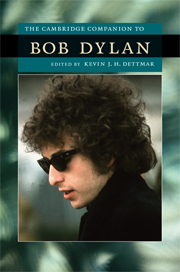Book contents
- Frontmatter
- Introduction
- Part I Perspectives
- 1 Bob Dylan and the Anglo-American tradition
- 2 Bob Dylan and Rolling Thunder
- 3 Bob Dylan as songwriter
- 4 Bob Dylan as performer
- 5 Bob Dylan and collaboration
- 6 Bob Dylan and gender politics
- 7 Bob Dylan and religion
- 8 Bob Dylan and the Academy
- 9 Bob Dylan as cultural icon
- Part II Landmark Albums
- Works cited
- Index
5 - Bob Dylan and collaboration
from Part I - Perspectives
Published online by Cambridge University Press: 28 May 2009
- Frontmatter
- Introduction
- Part I Perspectives
- 1 Bob Dylan and the Anglo-American tradition
- 2 Bob Dylan and Rolling Thunder
- 3 Bob Dylan as songwriter
- 4 Bob Dylan as performer
- 5 Bob Dylan and collaboration
- 6 Bob Dylan and gender politics
- 7 Bob Dylan and religion
- 8 Bob Dylan and the Academy
- 9 Bob Dylan as cultural icon
- Part II Landmark Albums
- Works cited
- Index
Summary
In this chapter I want to expand on the conventional meaning of “collaboration” to look at how Bob Dylan's use of musical, historical, and other cultural influences helped to shape him as a performer. This expansion will take two forms: the first follows a commonly accepted argument in literary theory, that works of art are the result not of individual artists working in isolation but rather the result of the collaboration of artists with their various historical, social, and personal influences; the second uses performance-studies theory to claim that artists remake themselves and create (perceptions of) reality through their performances, including live as well as recorded or written performances. Dylan has never been forthcoming about or particularly appreciative, publicly at least, of any collaborative help he has received, yet the help has sometimes been substantial. The initial assistance provided by Joan Baez goes generally unacknowledged by Dylan even though she provided him with the exposure and audiences he needed to start his career. Dylan also has downplayed the influence of Harry Smith's Anthology of American Folk Music, contending that many people had listened to it but also to many other songs, that his transient lifestyle at the time did not allow him to spend a great deal of time listening to any album, and that he and other young musicians preferred to hear these and other songs done live in the Village and elsewhere (Gilmore).
- Type
- Chapter
- Information
- The Cambridge Companion to Bob Dylan , pp. 69 - 79Publisher: Cambridge University PressPrint publication year: 2009



